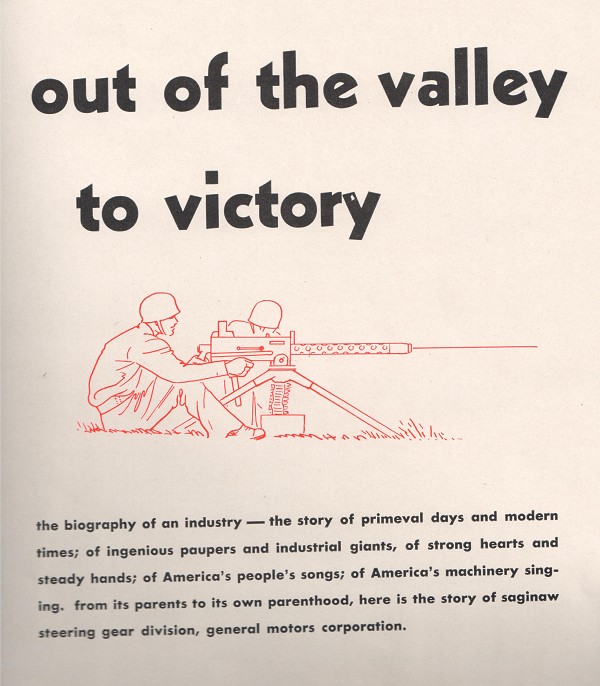| Home | Sports | Community | Arts/Theater | Business | Schools | Economy - Local |
| Downtown | The Scene | History | Health/Fitness | KA$H FOR KARAOKE | Groups & Non-Profits |

Book detailing production of arms for the U.S. military was published by the Steering Gear Division of GM in 1943. Why Did U.S. Win WW II? Saginaw Gun Plant Personified Patriotic Production
April 22, 2012
Leave a Comment
|
||||||||||||||
| Printer Friendly Story View |
One of the contributing factors to the U.S. victory in World War II was our war materiel machine.
Oldtimers have described Michigan auto plants being swept clean of equipment by bulldozers, being re-equipped and tanks rolling out several weeks later.
A Saginaw firm not only met Defense Department parameters for production speed and cost, it exceeded totals and lowered the price for the machine guns and rifles produced there.
Nexteer, formerly Saginaw Steering Gear, is continuing the tradition of industrial innovation and excellence with its truck steering units that are now dominating the market.
We have obtained a rare copy of a book published in 1943 by Saginaw Steering Gear Division of General Motors Corp. The 187 page book tells the early history of the area. The lumbering and agricultural character of the area took a historic turn with formation of the Jackson, Church and Wilcox company in 1906 for production of auto parts.
It was a prescient move; the industrial revolution was ramping up and the Saginaw firm had caught the wave. It patented a steering mechanism for Buick autos known as the "Jacox Gear," the book notes.
Demanding more and more gears, and finding the owners unwilling to risk the expense of a huge expansion, Buick purchased the company in 1910 and retained M.L. Wilcox as manager.
The embryo General Motors Corp. of Billy Durant purchased Buick that same year and expansion of the plant continued apace. In World War I, the plant became known as the Jackson, Church and Wilcox Division of GM.
By the time the war was winding up, in 1918, the plant had produced about 3 million trench mortar shells for the U.S. military.
The next venture was production of engines for Chevrolet and Oldsmobile cars and spawned the Grey Iron and Malleable Iron foundries.
"That such productive expansion would be accomplished in the short span of twelve years seems relatively impossible and, true, that would be, in any other place but America," the editors commented.
In 1926, a complete new design of steering gear was manufactured for Cadillac and soon the division became known as the Saginaw Steering Gear Division of GM.
In 1937 GM purchased the former S. Fair and Son's Foundry south of the plant and continued expansion.
As automobiles began to use balloon tires, a new and better steering device was required and the "recirculating ball nut gear" was devised by the firm.
In 1938, with war clouds looming in Europe and the Far East, the firm was notified it would soon receive an order from the War Department to produce machines, tools, dies and all equipment to produce .30 caliber Browning tank type machine guns in volume.
Money for the project was not available until June 15, 1940. The firm was to have the first machine gun completed and accepted by the Army no later than December, 1941. A new plant was constructed on Hamilton Avenue and on March 27, 1941, more than seven months ahead of schedule, the first machine gun ever to be made by an automobile firm was completed. It had 190 component parts.
By March 1942, when the plant was to have delivered 280 machine guns, the Detroit Ordnance District was amazed when 28,728 were delivered and quickly placed in the hands of America's soldiers.
Even more amazing was the fact that the Saginaw firm had lowered the price from $667 to $141 per gun by changing the method of producing rivets used in the guns' casing.
The plant then took on production of special armor-piercing projectiles for 37 mm tank cannon. Saginaw Gear licked a problem of hardening the metal in the shot and boosted production to 30,000 shot a day over the projected 24,000.
In July 1942 GM took over an unused Chevrolet plant in Atlanta, Georgia, and moved the machine gun shot production there. Costs were lowered to 50 percent of its original contracted cost. In 1942 GM received an Army-Navy "E" award for "excellence on the production front."
When a Grand Rapids arms plant could not deliver an acceptable .30 caliber carbine, the Saginaw firm was asked by the Defense Department to take over. In 33 days, 8,000 more carbines than the contract called for had been accepted by the Army.
The book summarized: "Within a short time, the Government added the only remaining honor it could bestow on the Division: The Star for Continued Meritorious Service."
Broadcaster and historian Eric Jylha commented last year at Saginaw Valley State University about little known aspects of industrial production in the Saginaw area during World War II:
"FDR called Michigan the Arsenal of Democracy, and it was. We all know about bombers and tanks being built in the Detroit area, but many don't know that the contributions of those in our region were just as significant."
"Saginaw made weapons at the Saginaw Steering Division, Plant 2 which was known as the "Gun Plant," Mr. Jylha said.
"The plant was built in 1941 when the division was contracted to build M1919 machine guns and M1-Carbines for the war.
"During this period, all production at the Defoe Shipbuilding Company in Bay City went to the war effort. From 1939 to 1945, the company built 154 ships, including four minesweepers, 11 fast transports patrol crafts, and numerous landing crafts.
"In Midland, Dow Chemical was a strategically important business as magnesium became important in fabricating lightweight parts for aircraft. Also, it was during this time that Dow and Dow Corning began their joint venture. Dow Corning produced silicones for military and later civilian use.
"The Great Lakes Bay Region's home-front army invented daycare and also housed prisoners of war. In fact, the prisoner of war camp at Tri-City airport housed more than 1,000 German POWs in 20 barracks."
We have written of the German prisoners housed in a former bank on Salzburg who worked in sugar beet cultivation and harvesting in local farms. The historic building, used by Kinde Distributing and other firms, is now for sale.
| Printer Friendly Story View |

|
Prior Article
March 5, 2025 by: Stephen Kent St. Patricks Parade 2025 - IT's TIME |

|
Next Article
February 10, 2020 by: Rachel Reh Family Winter Fun Fest is BACC Hot Spot for 2/10/2020 |
|
|

Dave Rogers |
|
|
|
Printer-Friendly Story View
0200 Nd: 06-27-2025 d 4 cpr 1
12/31/2020 P3v3-0200-Ad.cfm
SPONSORED LINKS
12/31/2020 drop ads P3v3-0200-Ad.cfm
